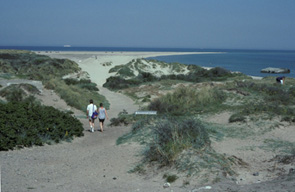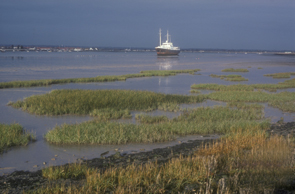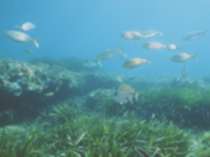Introduction to biodiversity of coastal and marine habitats and ecosystems
This article gives an introduction to the biodiversity of coastal and marine habitats, including those of transitional waters (e.g. estuaries). It is also meant as a guide to Coastal Wiki articles that deal with specific aspects of coastal and marine biodiversity. An important objective is the restoration and preservation of marine biodiversity.
Contents
The coastal zone
The coastal zone includes three overlapping areas. These are not mutually exclusive but often include transitions between habitats. Geomorphological characteristics and dynamics are described in several articles in the category physical coastal and marine processes. Key areas for the categorization of habitats and ecosystems are:
1. Terrestrial coastal habitats and ecosystems
Terrestrial coastal habitats and ecosystems lie above the limit of the tides but are influenced by coastal processes. They include cliffs, islands, sand dunes (Fig.1), shingle (boulder/pebble) beaches, sand banks and other habitats in close proximity to the sea.
2. Coastal habitats and ecosystems in transitional waters
Coastal habitats and ecosystems in transitional waters are subjected to tides, wave action and sediment transport, which help to form habitats such as salt marshes and mangroves. Estuaries (Fig. 2) and deltas provide a link between the land and the sea where tidal water and freshwater river flows interact.
3. Marine habitats and ecosystems
Marine habitats and ecosystems are found in the deep sea, open oceans and continental shelf. They include the seabed, coral reefs, seagrass meadows (Fig. 3) and the water column.
European Seas
The European seas range from the exposed Atlantic and North Sea to enclosed seas, such as the Baltic and the Mediterranean. The biodiversity of these seas varies considerably depending on their depth, surface areas, climatic conditions, position in relation to the Gulf Stream, tidal range etc.
Human activities
Throughout history, humans have exploited the coastal zone. Early occupation had little impact but as populations grew and with it, an ability to modify the environment, coastal areas were amongst the first to be altered. Reclamation for infrastructure, agriculture and other uses affect coastal zones around the world. The continuing attrition through coastal 'land claim' has resulted in the loss and degradation of many coastal habitats. When accompanied by a relative sea level rise the losses can be substantial. The process has become known as 'coastal squeeze' in the UK [1].
Many rivers and estuaries have become the conduit for disposal of human effluent and the sea a dumping ground resulting in eutrophication. Estuaries in particular also receive many polluting chemicals via river inputs and deposition from the atmospheric, which eventually reach the coastal seas. Some of the more toxic substances directly influence the health of marine/coastal species and through this the coastal and marine food chain and the functioning of entire ecosystems. These issues are described in Coastal and marine pollution. At the same time increased exploitation of coastal and marine resources, including commercial fishing deplete populations and reduce biodiversity.
Both coastal and marine habitats have seen an increase in the establishment of invasive, alien plant and animal species. This represents a significant threat to the marine environment, especially in relation to fishing.
Global climate change affect the coastal zone in a variety of ways, notably as a result of sea level rise and (possibly) an increased incidence and severity of storms. The effects on the marine environment include changes in primary production, recruitment (of commercial fish species), distribution and community structure. In addition to the impact on the natural environment, it may also affect the ability of the zone to provide the goods and services we rely upon.
Management and restoration
Against the background of damage and destruction, unsustainable exploitation and more recently the recognition of the implications of global warming, management and restoration of the zone have become more and more important. The interrelated nature of the coast requires an integrated response to these changes, including the restoration of damage caused by human activities. Addressing these issues in a balanced way calls for integrated coastal zone management based on methods for evaluation and assessment and on implementing restoration projects. Examples of good practice include case studies from around the world.
Marine Biodiversity
Marine biodiversity is generally high in terms of species number. It can be considered to have additional diversity components, which are manifested in both the structure and function of the marine environment.
Structural diversity has three elements that relate to Genetic diversity; Species diversity and Ecosystem diversity.
The second element in marine biodiversity relates to the its functional diversity. This reflects the biological and physical complexity of the ecosystem. In this case it involves the sea bed, the water column and sea surface and the interactions within and between the plant and animal communities.
Measurements of biodiversity
The number of different species in a given area provides a simple measure of biodiversity. On land this might be expressed as number of plant species per square metre quadrat. However, there are many ways of creating a biodiversity index, which are discussed in the article entitled Measurements of biodiversity.
A workshop was held on marine biological valuation, from 6 to 8 December 2006 at Ghent (Belgium). This provided a number of important discussion points and recommendations for evaluating marine biodiversity as part of a process of conservation and restoration.
Sampling tools
In the marine environment there are a number of ways of sampling marine life. These include those specifically designed to collect samples as well as those adapted from or using commercial methods.
Species lists
Species lists provide the primary information required to assess biodiversity. There are a number of web sites providing such information.
Notes
Marine biodiversity is influenced both by the actions that take place in the sea or in transitional waters. It is also affected by activities taking place on land hence an understanding of the relationship between the management of the sea, Integrated Coastal Zone Management (ICZM) and Integrated Water Resources Management (IWRM) is essential for effective decision making.
References
- ↑ Doody, J.P. (2004) 'Coastal squeeze' - an historical perspective. Journal of Coastal Conservation, 10/1-2, 129-138.
Please note that others may also have edited the contents of this article.
|


